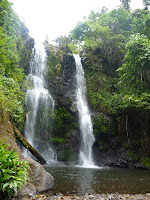I’m Africa bound! Hamsa, Tanzania, Rwanda, Mt. Kilimanjaro, safaris, Zanzibar – the vacation I’ve been saving up for all year – is almost within reach, 2 plane rides away. My first flight is from JFK to Dubai and it will take 12 hours. It’s the longest I’ve sat put in one place, the longest I’ve felt the earth’s landscape ebbing and flowing below me. Taking breaks from the constant stream of movies on my personal television screen, I fraternize with the clouds at eye-level. Daytime and nighttime announce themselves in silent blazes of color, forcing me to wonder: where do the hues of sunrises come from, where do those of the sunset go? It must be these upper skies that planes fly through. They rest here, before their shifts, keeping us company, transcending time zones and mocking confused watches. Here they wait: flat, unbroken bands of color; an even, unperturbed pulse of sky; the ingredients of a horizon; the steadiness of meditation.
Two Indian men are seated next to me, sporting Niagara Falls State Park Sandals. This cracks me up. What is it with Indians and Niagara Falls? I can’t explain our national compulsion to visit. Most stories I hear from Indian friends and family include claustrophobic drives to the Falls and Maid of the Mist ferry ride-induced sniffles. I have similarly fond – fondly similar? – memories, of course.
Antoine de Saint-Exupery, author of the well-known Le Petit Prince (The Little Prince), has a great passage in his Wind, Sand and Stars (thanks, Megan!) where African nomads (the Moors) encounter a waterfall for the first time. I reflected on it then, and you can now:
Memories that moved them too deeply rose to stop their speech. Some weeks earlier they had been taken up into the French Alps. Here in Africa they were still dreaming of what they saw. Their guide had led them to a tremendous waterfall, a sort of braided column roaring over the rocks. He had said to them:
It was sweet water. Water! How many days were they wont to march in the desert to reach the nearest well; and when they had arrived, how long they had to dig before there bubbled a muddy liquid mixed with camel's urine! Water! .... A thing worth its weight in gold! .... And this water, this miserly water of which not a drop had fallen at Port Etienne in ten years, roared in the Savoie with the power of a cataclysm as if, from some burst cistern, the reserves of the world were pouring forth.
“Come, let us leave,” their guide had said.
But they would not stir.
“Leave us here a little longer.”
They had stood in silence. Mute, solemn, they had stood gazing at the unfolding of a ceremonial mystery. That which came roaring out of the belly of the mountain was life itself, was the life-blood of man. The flow of a single second would have resuscitated whole caravans that, mad with thirst, had pressed on into the eternity of salt lakes and mirages. Here God was manifesting Himself: it would not do to turn one's back on Him. God had opened the locks and was displaying His puissance. The three Moors had stood motionless.
“That is all there is to see,” their guide had said. “Come.”
“We must wait.”
“Wait for what?”
“The end.”
They were awaiting the moment when God would grow weary of His madness. They knew Him to be quick to repent, knew He was miserly.
“But that water has been running for a thousand years!”
And this was why, at Port Etienne, they did not too strongly stress the matter of the waterfall. There were certain miracles about which it was better to be silent. Better, indeed, not to think too much about them, for in that case one would cease to understand anything at all.
--Wind, Sand and Stars; Chapter 7, Part III
[Picture taken at Marangu Falls, just outside the Marangu route entrance to the Kilimanjaro National Park.]


What a lovely beginning! I am rubbing my hands together in happy anticipation of reading the rest of your travelogue.
ReplyDeleteKamini.